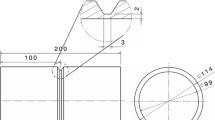Abstract
Pipes are basic elements used in the construction of pipelines for the long-distance transportation of oil and gas and their derivatives. They can be manufactured by cold forming processes such as UOE and ERW, both widely used in the oil and gas industry. These processes produce high levels of non-uniform plastic deformation, which introduce a new state of residual stress into the material. In some cases, these stresses combine with mechanical stresses generated by external loads leading to service failures, interrupting the transmission line and increasing the risk of accidents. Therefore, determining in advance the residual stress distribution in pipes is an important task which involves the evaluation of the structural integrity. Six pipe samples obtained by the UOE and ERW processes were measured and evaluated using a portable optical device that combines radial in-plane digital speckle pattern interferometer (DSPI) with the incremental hole-drilling technique to measure residual stresses. The experimental results indicate a distinct residual stress distribution for each manufacturing process, while the measured residual stress distributions in the longitudinal and circumferential directions were similar at all measurement locations along an individual pipe.









Similar content being viewed by others
References
Lu J (2005) Introduction. In: Lu J (ed) Handbook on residual stress, Vol. 1 residual stress: manufacturing and materials processing. 2nd ed. Society for Experimental Mechanics Inc., Bethel, pp xiii-xvii
Kudryavtsev YF (2008) Residual stress. In: Sharpe WN Jr (ed) Springer handbook of experimental solid mechanics. Springer Science & Business Media, New York, pp 371–386
Law M, Prask H, Luzin V, Gnaeupel-Herold T (2006) Residual stress measurements in coil, linepipe and girth welded pipe. Mater Sci Eng A 437:60–63
Wang J, Saraswat R, Mirzaee-Sisan A (2013) Influence of residual stresses on pipeline integrity: a state-of-the-art review. In: Rio Pipeline Conference & Exposition, Rio de Janeiro, Brazil, 1–10
Zheng JY, Zhang BJ, Liu PF, Wu LL (2012) Failure analysis and safety evaluation of buried pipeline due to deflection of landslide process. Eng Fail Anal 25:156–168
Viotti MR, Albertazzi Jr. A (2009) Industrial inspections by speckle interferometry: general requirements and case study. Proc. SPIE 7389, P. H. Lehmann ed. 73890G-1-73890G-15
Pacheco A, Viotti MR, Veiga CLN, Albertazzi A Jr (2016) Evaluation of bending stresses in pipelines by using hole-drilling measurements combined with interferometry. Exp Mech 56:133–143
Kyriakides S, Corona E (2007) Mechanics of offshore pipelines, Vol. 1 buckling and collapse. Elsevier, Oxford
Raffo J, Toscano RG, Montovano L, Dvorkin EN (2007) Numerical model of UOE steel pipes: forming process and structural behavior. In: Mecánica Computacional XXVI. Córdoba, Argentina, pp 317–333
Herynk MD, Kyriakides S, Onoufriou A, Yun HD (2007) Effects of the UOE/UOC pipe manufacturing processes on pipe collapse pressure. Int J Mech Sci 49:533–553
Deng H, Ben-Zvi A, Wiskel JB, Henein H (2010) B-spline approximation methods for digital image reconstruction in strain measurement. J Mater Process Tech 210:593–602
Gou R, Zhang Y, Xu X, Sun L, Yang Y (2011) Residual stress measurement of new and in-service X70 pipelines by X-ray diffraction method. NDT&E Int 44:387–393
API Specification 5L (2012) Specification for line pipe, 44th ed. American Petroleum Institute
ASTM E387-13a (2013) Standard test method for determining residual stresses by the hole-drilling strain-gage method. Annual Book of ASTM Standards. American Society for Testing and Materials
Viotti MR, Albertazzi A Jr (2013) Compact sensor combining digital speckle pattern interferometry and the hole-drilling technique to measure nonuniform residual stress fields. Opt Eng 52:101905 1–101905 8
Viotti MR, Albertazzi A Jr, Kapp WA (2008) Experimental comparison between a portable DSPI device with diffractive optical element and a hole drilling strain gage combined system. Opt Lasers Eng 46:835–841
Montgomery DC, Runger GC (2003) Applied statistics and probability for engineers, 3rd edn. Wiley, New York
Schajer GS, Whitehead PS (2013) Hole drilling and ring coring. In: Schajer GS (ed) Practical residual stress measurement methods. Wiley, Chichester, pp 51–61
Acknowledgments
The authors would like to thank the technician Elsio Varela for helping with the measurements. We also acknowledge Petrobras for providing the pipes and for financially supporting this research.
Author information
Authors and Affiliations
Corresponding author
Rights and permissions
About this article
Cite this article
Lothhammer, L.R., Viotti, M.R., Veiga, C.L.N. et al. Experimental Evaluation of Residual Stresses in Pipes Manufactured by UOE and ERW Processes. Exp Mech 57, 287–296 (2017). https://doi.org/10.1007/s11340-016-0219-1
Received:
Accepted:
Published:
Issue Date:
DOI: https://doi.org/10.1007/s11340-016-0219-1




